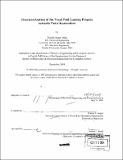| dc.contributor.advisor | Robert S. Langer. | en_US |
| dc.contributor.author | Hahn, Mariah S | en_US |
| dc.contributor.other | Massachusetts Institute of Technology. Dept. of Electrical Engineering and Computer Science. | en_US |
| dc.date.accessioned | 2005-09-27T17:56:44Z | |
| dc.date.available | 2005-09-27T17:56:44Z | |
| dc.date.copyright | 2004 | en_US |
| dc.date.issued | 2004 | en_US |
| dc.identifier.uri | http://hdl.handle.net/1721.1/28715 | |
| dc.description | Thesis (Ph. D.)--Massachusetts Institute of Technology, Dept. of Electrical Engineering and Computer Science, 2004. | en_US |
| dc.description | Includes bibliographical references. | en_US |
| dc.description.abstract | During normal speech, human vocal folds sustain greater than 100 high impact collisions each second. When the pliability of this complex biomechanical system is reduced by scarring, voice quality may be compromised. Currently, little can be done to treat patients affected with voice loss or chronic voice impairment due to scarring. Because of the size of the patient population suffering from voice impairment secondary to scarring, alternate treatment methods are currently being actively investigated. An implant-based approach is one strategy for treating lamina propria scarring. To rationally design an implant material for this purpose, it is important to have a more complete understanding of lamina propria biochemistry and microstructure than is currently in literature. This dissertation presents the following critical insights into normal human lamina propria biochemical structure: 1.) quantitative analysis of collagen, elastin, hyaluronan, and proteoglycan presence; 2.) quantitative examination of the spatial distributions of collagen, elastin, and hyaluronan, and qualitative investigation of the spatial distributions of specific proteoglycan types; and 3.) assessment of total cellularity and spatial variations in extracellular matrix turnover. Similar analyses have been carried out on the vocal fold lamina propria of normal dog, pig, and ferret towards identifying an appropriate animal model for implant trials. | en_US |
| dc.description.statementofresponsibility | by Mariah Somer Hahn. | en_US |
| dc.format.extent | 98 leaves | en_US |
| dc.format.extent | 6682747 bytes | |
| dc.format.extent | 6694140 bytes | |
| dc.format.mimetype | application/pdf | |
| dc.format.mimetype | application/pdf | |
| dc.language.iso | en_US | |
| dc.publisher | Massachusetts Institute of Technology | en_US |
| dc.rights | M.I.T. theses are protected by copyright. They may be viewed from this source for any purpose, but reproduction or distribution in any format is prohibited without written permission. See provided URL for inquiries about permission. | en_US |
| dc.rights.uri | http://dspace.mit.edu/handle/1721.1/7582 | |
| dc.subject | Electrical Engineering and Computer Science. | en_US |
| dc.title | Characterization of the vocal fold lamina propria towards voice restoration | en_US |
| dc.type | Thesis | en_US |
| dc.description.degree | Ph.D. | en_US |
| dc.contributor.department | Massachusetts Institute of Technology. Department of Electrical Engineering and Computer Science | |
| dc.identifier.oclc | 59552867 | en_US |
